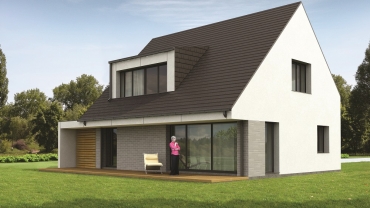
Building blocks: what are their main characteristics?
Comparing building blocks with each other is quite difficult because due to different nature of the materials, some parameters are important to one kind while others to other kind. However, all the blocks must be able to withstand the strains of the building, insulate sound and a little bit of heat. The most important parameters of blocks are described by VGTU (Vilnius Gediminas Technical University) Institute of Thermal Insulation, Thermal insulation materials science laboratory scientists Dr. Vladislovas Keršulis Dr. Sigitas Vėjelis and building materials laboratory scientist Dr.Viktoras Kizinievic.
Variety and market of the Blocks
Building brick walls is a very important and responsible stage of construction. There was a constant search for ways to improve the quality of masonry, cut costs and speed up the constructive works. The emergence of building blocks that are much larger than bricks quickly became a popular choice. They are lighter and easier than traditional bricks and are laid much faster. Building blocks market is constantly enriched with new products, so it is sometimes hard for the customers to know what is what, especially since the blocks often are selected by their price. Brands such as Fibo, Arko, Kerapor, Izoblok, brother, Durisol, Siliblokas, Poritas and Haus are among the most often talked about.
Dainius Mažulis, the CEO of the company "Trys D”, representing Haus concrete blocks manufacturer, had stated that each manufacturer produces different blocks from the same material. For example, blocks produced by the Haus company differ from other concrete blocks with its shape and size of hollow cavities and they have a full bottom.
Sigitas Česokas, managing director of "Simpras” company, representing producers of ceramic and silicate blocks, noted that sometimes the parameters of blocks produced by different companies are very different, although most blocks are made of similar materials. "Unfortunately, the prevailing emphasis is on the price of the blocks, not the brands, guaranteeing a certain set of parameters and the properties of the materials from which they are made," - he said.
Standards
Lithuania formally applies BS EN 771 series of standards of "Technical requirement for masonry products" for each type of product, which lay down the ceramic, silicate, concrete (with dense and lightweight fillings such as clay), autoclaved aerated concrete products technical requirements. The standards do not describe so-called light foam concrete blocks.
There are many other products made of basic materials that differ in proportions of additives and fillers. For example, wood chips mixed with the concrete or polystyrene granules with concrete, lightweight concrete blocks with various fillings.
All the building blocks are certified according to the standards adopted by EU and Lithuania.
However, not all products that reach the market of Lithuania, have certificates of conformity. Those products whose testing in laboratories proved them unsuitable, usually are not certified by the importers. However, it does not mean that such defective products are off the market.
Last year, a shipment of the glass wool products from China had arrived in Lithuania. It was cheap but unfortunately defective. Many people bought it but later they ended up being very disappointed. Similar situations happen in the market of the building blocks too. Those importers who are not sure of the quality normally import small quantities of non-certified products. Such behavior is typical of small, one-day companies who sell blocks at a cheaper price and try to get rid of them as quickly as possible. So it is always worth it to check whether the products are certified for distribution in the markets of the EU. Some EU countries make additional requirements for such products.
How important are the thermal properties of the blocks?
Homes built from the blocks as well as from other materials thermal resistance is regulated by Article 2.05.01: 2005 "Thermal technique for barriers of the buildings”, according to which thermal resistance of the external barrier must not be less than 5 sq. m. K/W. No blocks without a layer of thermal insulation can meet this requirement. If we assume that the average heat transfer coefficient in blocks is 0.2, then to reach 5 sq. m. K/W resistance, the wall of blocks should be about 1 m thick. Nobody builds walls of such thickness. Insulation materials are used instead and they determine the thermal properties of the building. Blocks or other materials only compose a frame with the attached insulation material. Thermal Insulation Institute researchers believe that since the introduction of the requirement for heat resistance of not less than 5 sq. m. K/W, the value of thermal performance of the blocks was largely diminished.
Thermal insulation properties of the building are determined by thermal material - its thickness and composition quality.
IMPORTANT
It is not recommended to use metal profiles for attachment of the insulation material because they are potential thermal bridges. To improve the thermal resistance, it is recommended to use adhesives for its attachment.
Some manufacturers of the blocks emphasize the advantage of large dimensions of the products. When such blocks are laid out, it results in fewer seams, which may also be potential thermal bridges. Researchers say that the influence of the building blocks to thermal insulation properties of the building is low, and the influence of the seams is even less. Material and size of the blocks has no crucial influence on thermal insulation properties of the building. Building blocks used in the external walls of brick, the thermal properties of much more important is the strength, frost resistance and acoustic performance.
Alternatives sellers appear on the market, declaring that, for example, that outer wall resistance of their 35 cm wide blocks reaches up to 6.5. However, in this case, they must have documents that can prove such claim, and builders should calculate what is better to buy - more expensive blocks or thermal insulation materials.
Compressive strength
Thermal Insulation Science Institute scientists claim that the most important feature the building blocks is their strength under compression. The brick and block manufacturers must declare the average compressive strength of the product.
The protocols of the tests carried out by the Institute show that silicate and ceramic brick blocks are the strongest in this regard. In fact, it is true that blocks of lower strength are usually sufficient for one or two-storey buildings. Problems may occur only over large openings in the walls.
Frost resistance
Frost resistance of the blocks is checked according to how many freezing-thawing cycles material can withstand. Scientists believe the building blocks are not finishing materials that are constantly exposed to the atmosphere. They are only the shell material, whose structure is protected by thermal insulation and finishing. Frost and humidity do not affect them directly. However, the blocks must have minimum resistance to frost, it is important at a time when they are still at the construction site or while unprotected by insulation materials.
The frost resistance of the blocks is important in areas where they are reached by the moisture of the soil.
Scientists do not take on the task to compare the blocks made of different materials and their frost resistance because very often they are tested by different methods: different cooling-thawing cycle test modes and different requirements for materials.
Each material has different requirements of resistance to frost. For example, frost resistance of porous concrete is evaluated according to the reduction of compressive strength and weight loss.
In Lithuanian weather conditions, building blocks should withstand at least 25 cycles of frost. Frost resistance of ceramic tiles is 25 cycles. According to the standard for concrete masonry units, a minimum cycle is 25 cycles as well.
All manufacturers declare cooling-heating cycles from 15 to 200 or more. Lithuanian manufacturers often refer to 20-35 cycles of frost resistance. Thermal Insulation Institute scientists claim that if there is no direct frost impact on the masonry, so there is no need for a greater number of cycles. The manufacturers often use them for promotional purposes.
Acoustics
Each material is described by its density, water absorption, compressive strength, etc. The complex of all these features determines thermal, structural and acoustic properties of the blocks.
From the acoustic point of view, substances are divided into the sound absorbing and sound insulating. Sound insulation is greatly influenced by the mass of the blocks: the denser and heavier they are; the better sound insulation will be. Mineral wool improves sound absorption between the bearing and finishing layers.
Porous material also absorbs sound well, but its thickness should be sufficient to achieve the desired effect.
For a block wall to insulate sound well, it is necessary that to fill the gaps completely between the blocks. The blocks must be very precisely vertically merged and covered with the plaster layer of uniform thickness.
Humidity resistance
Moisture resistance is not very important for structures protected from the outside but it is important during storage and bricklaying time. For different products, this parameter is set differently. The parameter for concrete with lightweight aggregate and autoclaved aerated concrete products is determined by capillary water absorption rate - how many grams of water are absorbed into 1square meter per second. This feature is relevant to expanded clay.
A relative value of the drying shrinkage is also important for autoclaved aerated concrete products because porous concrete has space for movement. Silicate and ceramics are moving less.
Water absorption rate - how much water is absorbed by the material over a specific time is important for ceramic and silicate masonry units.
Blocks are divided into several categories by dimensional accuracy. It is determined by the equipment of the producers. The more precise dimensions of the blocks are, the less mortar is required, the straighter the wall will be, the smaller the tolerances and better acoustic and thermal insulation properties.
Danutė Ramoškevičiūtė



